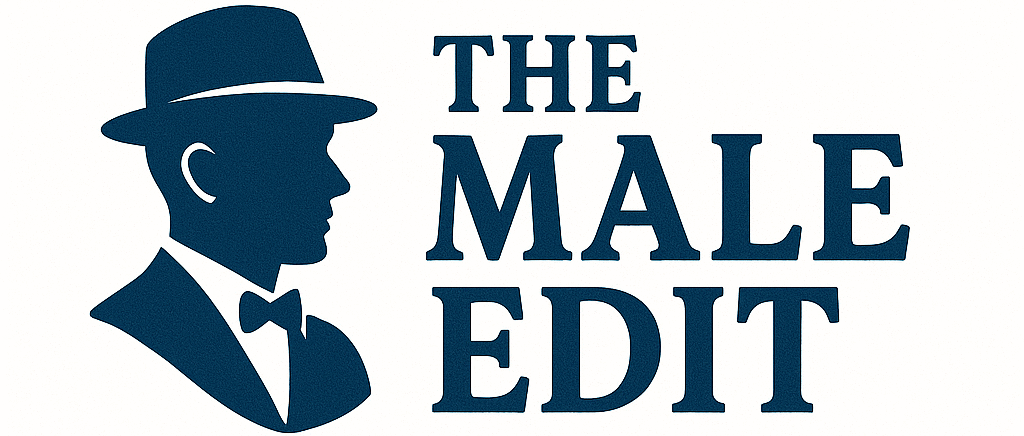Getting the perfect leg tattoo starts with choosing the right stencil design. We’ve seen countless men struggle with finding artwork that complements their leg’s natural contours while expressing their personal style. The key lies in understanding which stencil patterns work best for different leg areas and body types.
Leg tattoos offer incredible versatility – from bold tribal designs wrapping around calves to intricate sleeve-style pieces covering entire legs. We’ll explore how the right stencil can transform your vision into stunning body art that stands the test of time.
Whether you’re planning your first leg tattoo or adding to an existing collection, selecting the perfect stencil design requires careful consideration of placement, size, and artistic style. We’ll guide you through the most popular leg tattoo stencil options that work exceptionally well for men’s anatomy and lifestyle needs.
Understanding Leg Tattoo Stencils for Men: The Foundation of Great Ink
Leg tattoo stencils serve as the blueprint for transforming your vision into permanent art on your skin. We need to understand how these templates work before diving into the application process. Stencils act as precise guides that ensure your tattoo artist can deliver clean lines and accurate proportions.
Transfer paper stencils represent the most common method used in professional tattoo shops. Artists create these by printing or drawing the design onto special transfer paper, then applying it directly to your leg. The process involves using a stencil solution that helps the ink transfer clearly onto your skin, creating a temporary outline that lasts throughout the tattooing session.
Thermal copier stencils offer enhanced precision for complex leg tattoo designs. These machines create darker, more detailed impressions that won’t smudge during longer tattoo sessions. Many artists prefer this method for large leg pieces because the stencil remains visible even as the session progresses.
Freehand stencils provide flexibility for custom leg tattoo artwork. Some experienced artists sketch directly onto your leg using specialized markers, allowing for real-time adjustments based on your leg’s natural contours. This approach works particularly well for organic designs like biomechanical pieces or flowing tribal patterns.
Size considerations play a crucial role in leg tattoo stencil effectiveness. We recommend discussing the scale with your artist before creating the stencil, as leg proportions can dramatically affect how designs appear. A stencil that looks perfect on paper might need adjustments when applied to your exact leg dimensions.
Placement accuracy depends heavily on proper stencil application techniques. Your tattoo artist should position the stencil while you’re standing in a natural pose, ensuring the design aligns correctly with your leg’s movement and muscle structure. This prevents distortion that could occur if the stencil is applied while you’re lying down or in an unnatural position.
Choosing the Right Placement on Your Leg for Maximum Impact
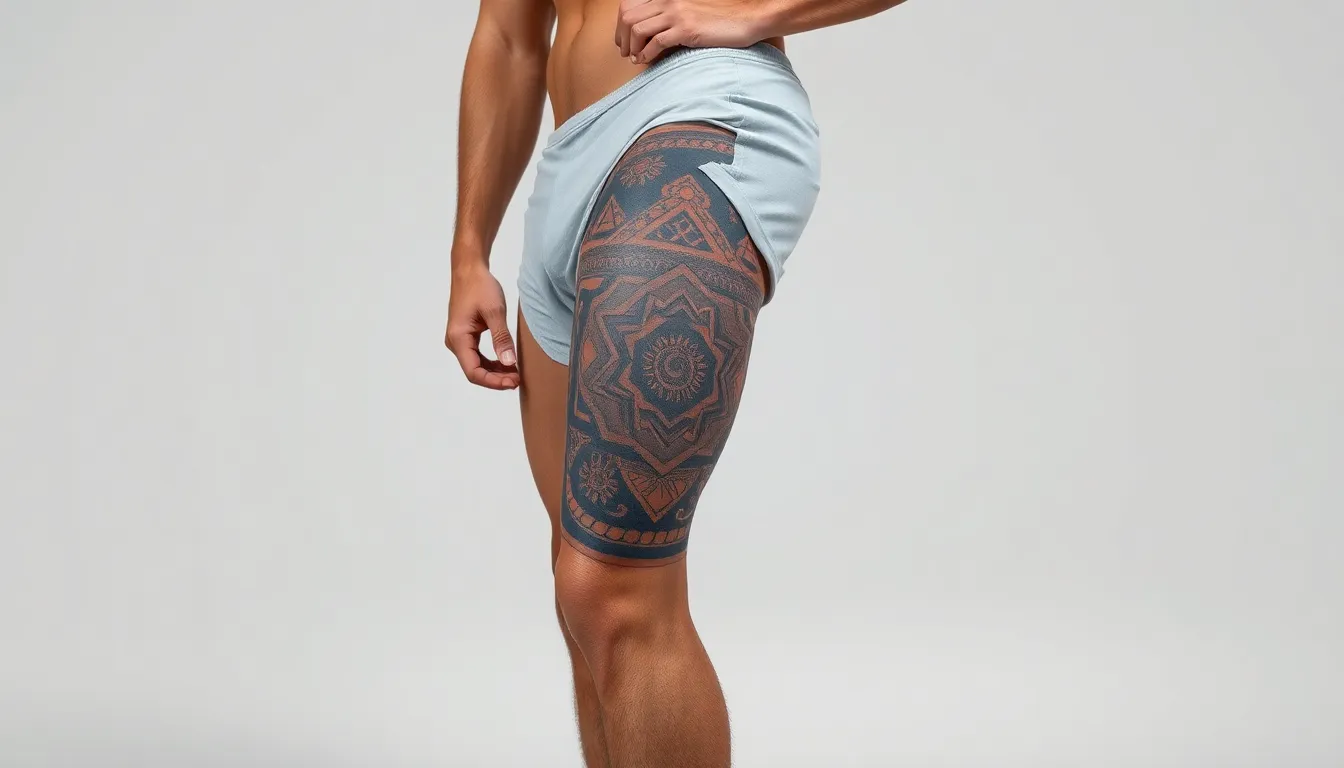
Placement decisions significantly influence how your leg tattoo stencil translates into the final artwork. We’ll explore the key areas that offer distinct advantages for different design styles and personal preferences.
Thigh Placement Considerations
Expansive canvas options make the thigh ideal for large, intricate stencil designs that require substantial space. We recommend this placement for geometric patterns, detailed portraits, or cultural symbols that benefit from generous proportions.
Versatile visibility control allows you to easily conceal or reveal thigh tattoos depending on your clothing choices. Business professionals often prefer this placement since it offers complete discretion during work hours while maintaining impact during casual settings.
Creative freedom flourishes in the thigh area due to its ample surface area and relatively flat contours. Complex stencil designs with multiple elements or interconnected patterns work exceptionally well in this location.
Muscle definition enhancement occurs naturally as thigh tattoos follow the leg’s muscular structure, creating ever-changing visual effects during movement.
Calf Design Opportunities
Medium to large designs find their perfect home on the calf, striking an ideal balance between visibility and coverage options. We’ve observed that tribal patterns, animal imagery like lions or eagles, and abstract designs particularly suit this curved surface.
Strength symbolism resonates powerfully through calf tattoos, as this muscular area naturally emphasizes themes of power and heritage. Traditional stencil designs often incorporate bold lines that complement the calf’s natural definition.
Ever-changing visual impact results from the calf’s curved shape, which allows stencil designs with high contrast and bold outlines to create striking three dimensional effects.
Popular motif success includes wildlife imagery, cultural symbols, and geometric patterns that wrap naturally around the calf’s contours.
Shin and Ankle Options
Limited space advantages make shin and ankle placements perfect for smaller, precision stencil designs that pack maximum visual punch. We recommend minimalist tattoos or clear lined symbols that fit these narrower areas effectively.
Vertical design opportunities work exceptionally well on the shin, accommodating elongated stencil patterns or script based designs that follow the leg’s natural lines.
Durability considerations become crucial for ankle tattoos, as frequent sun exposure and constant movement can affect design longevity. We suggest bold, simple stencils that maintain their integrity over time.
Angular shape compatibility suits geometric stencils and abstract designs that work within the shin’s straight lines and the ankle’s compact dimensions.
Popular Leg Tattoo Stencil Designs That Men Love
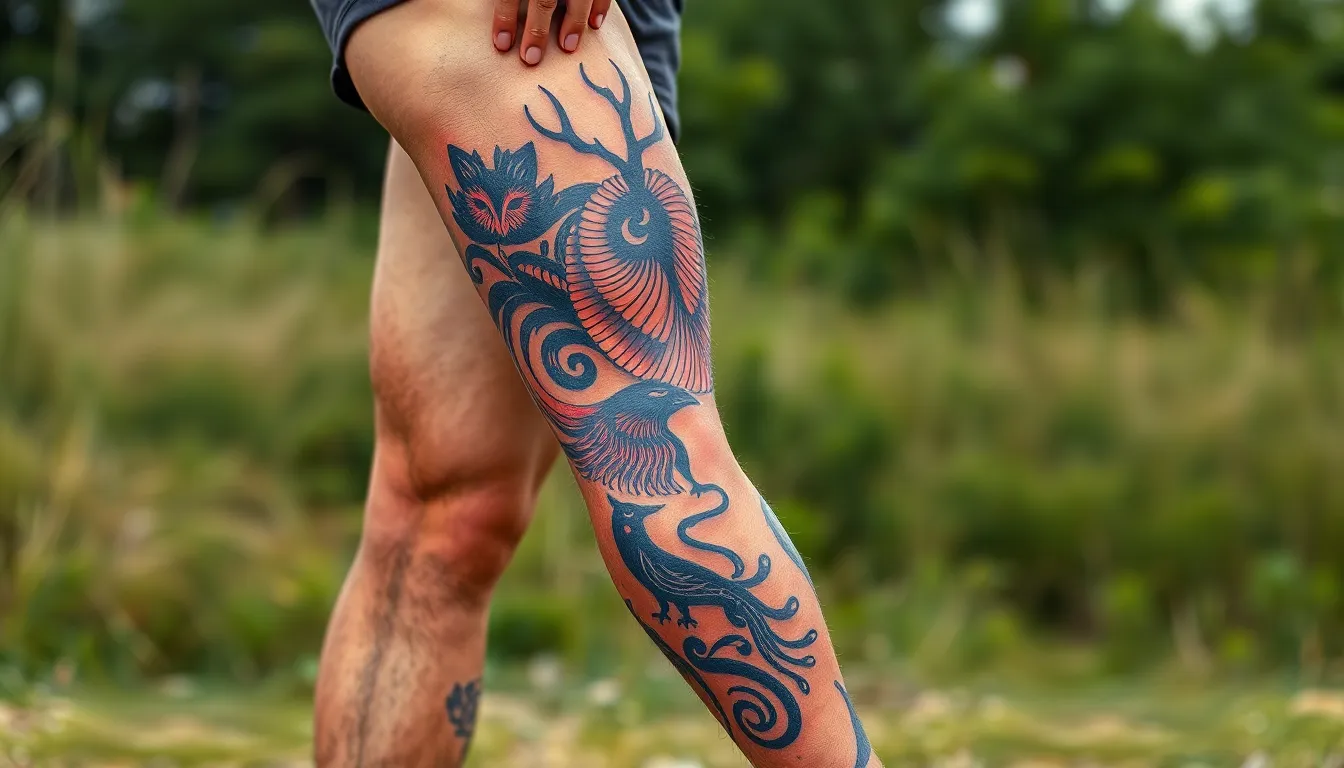
Men gravitate toward exact stencil designs that maximize the leg’s natural canvas while reflecting masculine aesthetics. These popular design categories offer versatility and powerful visual impact for leg placement.
Tribal and Geometric Patterns
Tribal patterns dominate men’s leg tattoo choices due to their bold visual impact and cultural significance. These designs emphasize strong lines and symmetrical elements that symbolize strength, heritage, and personal identity. Geometric shapes complement the leg’s natural contours while conveying precision and individuality through their structured appearance.
We see these patterns excel on the calf and thigh areas where their bold outlines create striking contrast against muscle definition. Traditional Polynesian motifs, Celtic knotwork, and modern geometric mandalas translate exceptionally well into stencil format. The clean lines inherent in these designs make them perfect for the stencil application method.
Nature and Wildlife Themes
Animal motifs lead the nature category with lions and eagles representing courage, power, and freedom in men’s leg tattoos. These detailed designs adapt beautifully to the leg’s shape while maintaining their symbolic strength. Trees, mountains, and floral elements express connection to the natural industry and personal growth themes.
Wildlife stencils work particularly well wrapped around the calf or positioned on the thigh where their intricate details can be fully appreciated. Bears, wolves, and predatory birds create powerful statements that resonate with masculine energy. Industry elements like forest scenes or mountain ranges provide backdrop options that enhance the primary animal subjects.
Skull and Gothic Imagery
Skulls and gothic symbols appeal to men seeking edgier, rebellious themes in their leg tattoo designs. These designs use strong blackwork and bold outlines to create dramatic visual effects that suit the leg’s prominent placement. Dark imagery often combines with other gothic elements like roses, crosses, or horror motifs for enhanced dramatic impact.
We find these designs particularly effective when they incorporate mortality themes or represent overcoming challenges. Day of the Dead skulls, traditional skull and crossbones, and ornate gothic architecture translate well through stencil application. The high contrast nature of these designs ensures they remain visually striking even in stencil format.
Sports and Hobby-Related Designs
Sports enthusiasts select leg stencils that celebrate their athletic passions through football imagery, motorcycle designs, or musical instruments. These personalized choices serve as lifestyle statements that showcase achievements and interests. The leg’s flexible canvas accommodates various sports equipment representations and team logos effectively.
Hobby related stencils might include guitar silhouettes for musicians, motorcycle engines for riders, or athletic equipment for sports professionals. We observe these designs work best when they incorporate personal elements that tell individual stories. Team emblems, championship dates, and achievement symbols add meaningful context to these passion driven tattoo choices.
Creating Custom Leg Tattoo Stencils for Unique Masculine Art
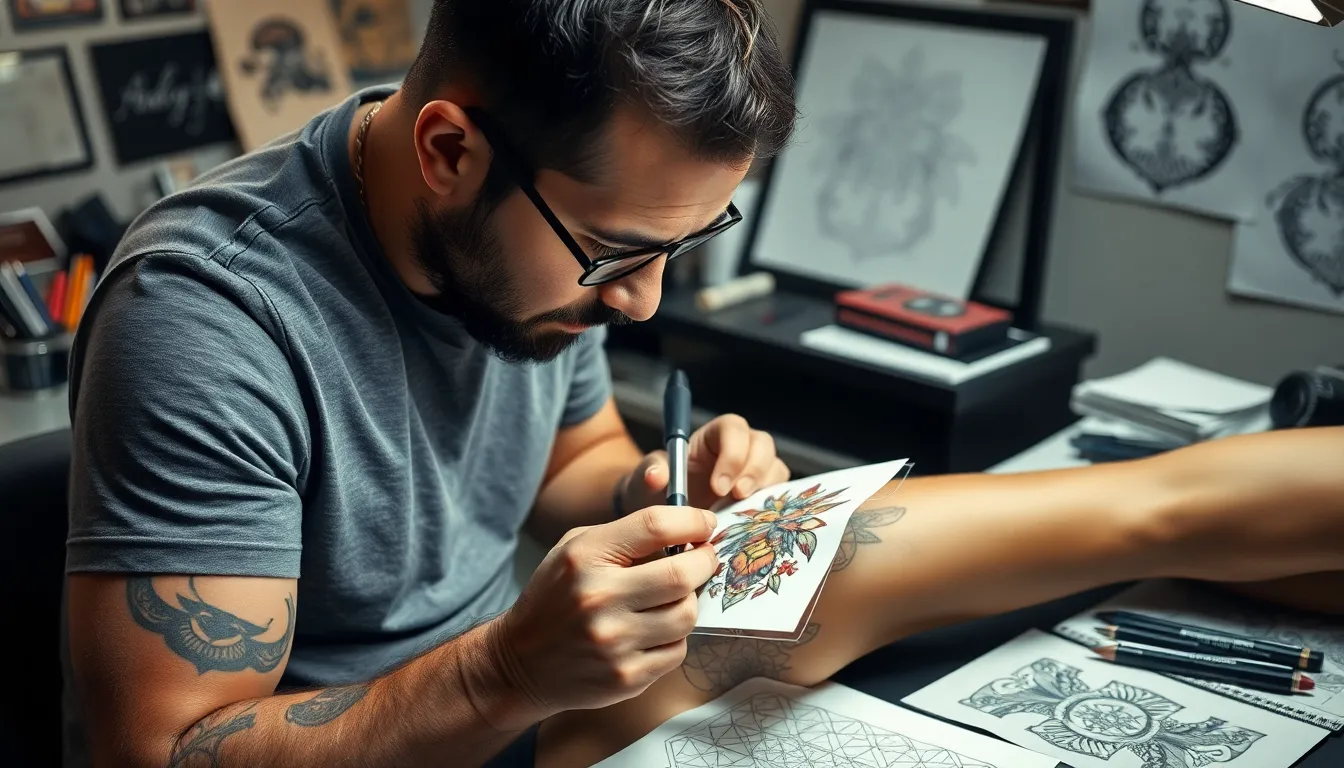
Building on the foundation of design selection and placement, we’ll explore how custom stencil creation transforms your vision into detailed, masculine artwork that flows naturally with your leg’s anatomy.
Working With Your Tattoo Artist
Collaboration with a skilled tattoo artist transforms your stencil concept into a masterpiece that complements your leg’s natural contours. We recommend scheduling multiple consultation sessions to discuss how geometric shapes, animals, mythological creatures, and abstract designs will flow across your exact leg structure. Artists use professional techniques to transfer stencil designs precisely onto skin before inking, ensuring consistency and preserving intricate details throughout the tattooing process.
Open communication about theme preferences, size requirements, and exact placement helps artists tailor the design to your body type and personal style. Most experienced tattoo artists will suggest modifications to enhance the visual impact based on your leg’s muscle definition and movement patterns. Planning becomes especially crucial for leg sleeve tattoos that cover from ankle to thigh, as these large canvas pieces require careful consideration of how detailed stories or bold imagery like dragons and biomechanical designs will connect seamlessly.
Digital Design Tools and Software
Modern tattoo studios increasingly use advanced digital design software to create and preview custom leg stencil designs with remarkable precision. AI powered 3D virtual try-on technology allows us to visualize exactly how your chosen tattoo will appear on your exact leg shape before any permanent work begins. These innovative tools improve decision making and significantly increase client satisfaction by eliminating guesswork from the design process.
Digital platforms enable artists to achieve precise control over lines, shapes, and proportional scaling that’s essential for bold, clean stencil designs suited specifically for leg tattoos. We can adjust geometric patterns, refine tribal elements, and perfect symmetrical designs using software that maintains consistent line weights and spacing. Professional design programs also allow for easy modification of existing templates, ensuring your masculine leg tattoo reflects your unique personality while maintaining technical excellence.
Hand-Drawn Stencil Techniques
Even though technological advances, hand drawing remains a highly valued technique for creating truly unique leg tattoo stencils that showcase personal artistic touches. Artists typically begin with detailed sketches on specialized paper, carefully refining each line and detail to create stencils that emphasize bold outlines and strategic minimal shading. This traditional approach allows for real-time adjustments that enhance the final tattoo’s flow and style, particularly beneficial for complex leg sleeves or symbolic motifs.
Hand-drawn methods provide unmatched flexibility when adapting designs to your leg’s exact contours and muscle structure. We can incorporate subtle variations in line thickness and organic curves that digital tools sometimes struggle to replicate naturally. Many artists combine hand-drawn foundations with digital refinement, creating hybrid stencils that capture both artistic spontaneity and technical precision for your masculine leg tattoo design.
Sizing Your Leg Tattoo Stencil for Optimal Visual Appeal

Selecting the right size transforms a good leg tattoo into an exceptional one that perfectly complements your body’s natural proportions. We’ve organized these sizing options to help you make the best choice for your vision and lifestyle.
Small and Minimalist Designs
Small tattoos measuring 2-4 inches work beautifully for men seeking subtle yet meaningful artwork. These compact designs excel in discrete locations like the lower calf, ankle, inner leg, or near the knee where they won’t overwhelm your leg’s natural shape.
Minimalist stencils offer incredible versatility for professional environments. You’ll find these designs easy to conceal when needed while still expressing your personal style through clean lines and thoughtful symbolism.
Budget conscious tattoo enthusiasts appreciate the 1-3 hour time commitment. Small leg tattoos typically cost between $100-$300 depending on detail complexity, making them an accessible entry point for first time tattoo recipients.
Placement flexibility makes small designs perfect for testing your tattoo tolerance. We recommend starting with these sizes if you’re unsure about pain levels or want to gauge how tattoos fit into your daily routine.
Medium Coverage Options
Medium sized stencils spanning 4-8 inches create the perfect balance between visibility and proportion. These designs thrive on the upper calf, lower thigh, or side of the leg where they have enough space to showcase detail without overpowering your leg’s contours.
Detailed artwork becomes possible at this size range while maintaining visual harmony. You’ll discover that medium tattoos allow for intricate elements like shading, texture, and multiple design components that smaller tattoos can’t accommodate.
Session planning becomes more structured with 3-5 hour appointments. Expect to invest $300-$500 for medium coverage tattoos, with many artists preferring single session completion to maintain design consistency.
Popular body parts including the calf, thigh, and shoulder areas suit medium tattoos exceptionally well. Men looking for noticeable yet manageable artwork find this size range offers the best of both worlds for everyday wear.
Large Statement Pieces
Large tattoos measuring 8 inches and beyond transform your leg into a stunning artistic canvas. These bold designs excel when placed on the full calf, full thigh, or extending from ankle to knee for maximum visual impact.
Intricate artwork reaches its full potential through expansive sizing options. You’ll experience the true artistry of detailed tattoos when working with statement pieces that allow for complex shading, multiple elements, and sophisticated composition techniques.
Multiple session planning becomes essential for 5-8+ hour tattoo experiences. Large leg tattoos typically range from $500 to $1000+ depending on complexity, with most artists scheduling 2-4 appointments to ensure quality and comfort.
Full leg sleeves and large thigh pieces represent the pinnacle of masculine tattoo artistry. These statement tattoos command attention while showcasing your commitment to exceptional body art that tells a complete visual story.
Preparing Your Leg for Stencil Application and Tattooing
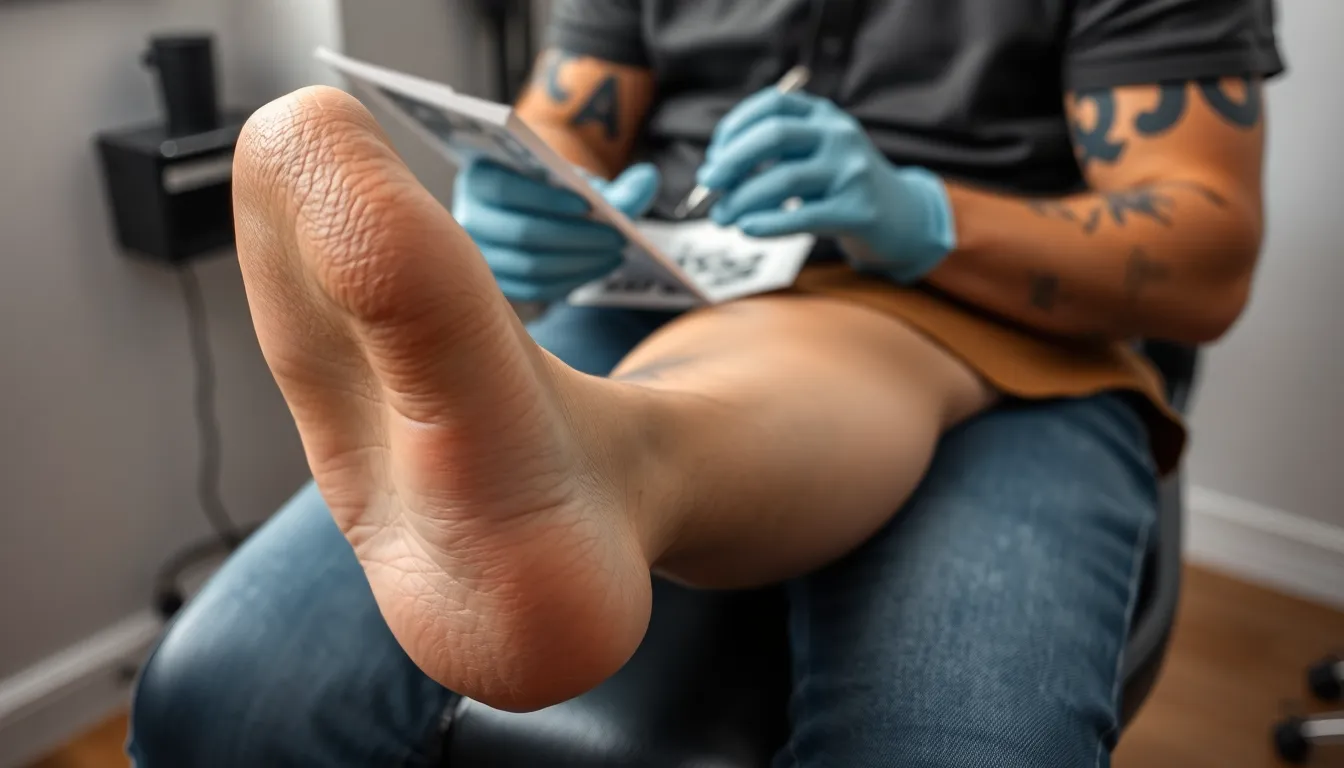
Proper preparation creates the foundation for successful stencil application and ensures clean, precise tattoo lines. We’ll guide you through each essential step to achieve optimal results.
Skin Preparation Steps
Start with thorough cleaning using a green soap mixture applied with a paper towel or spray bottle. This professional-grade cleaning solution removes surface dirt and prepares the skin for deeper sanitation. Professionals recommend this initial step because it eliminates basic contaminants that could interfere with stencil adhesion.
Follow up with comprehensive alcohol cleaning using isopropyl alcohol or hand sanitizer. Wipe the area multiple times with alcohol-soaked cloth or paper towel to disinfect and degrease the skin completely. This step removes natural oils and sweat that prevent proper stencil transfer.
Apply stencil primer or transfer solution to enhance adhesion once the skin is clean and dry. These specialized products create an optimal surface for stencil application and help maintain design integrity throughout the tattooing process. Quality preparation products ensure your stencil won’t smudge or fade during the session.
Hair Removal Considerations
Shave the entire leg area where your tattoo will be placed using a fresh, sharp razor. Hair removal is necessary because even fine leg hair can interfere with stencil clarity and prevent proper adhesion to the skin surface. Professional tattoo artists always perform this step before stencil application.
Take your time during the shaving process to prevent cuts or irritation that could complicate tattooing. Shave slowly and carefully, following the natural contours of your leg muscles. Rushing this step can result in nicks that delay the tattooing process and affect stencil placement.
Consider shaving 24 hours before your appointment if you have sensitive skin prone to razor burn. This timing allows any minor irritation to subside while keeping the area hair-free for optimal stencil application. Some men find this approach reduces discomfort during the actual tattooing session.
Proper Cleaning Techniques
Begin with soap and water cleaning to remove basic dirt and debris from the leg surface. This foundational cleaning step prepares the skin for more intensive sanitization and ensures no particles interfere with stencil transfer. Use mild, fragrance-free soap to avoid skin irritation.
Disinfect the cleaned area thoroughly with alcohol-based answers to eliminate bacteria and oils. Apply the alcohol solution generously and allow it to air dry completely before proceeding with stencil application. This step is crucial for both hygiene and stencil adherence.
Pat the stenciled area lightly with a paper towel after application to remove excess transfer solution. Avoid rubbing or aggressive wiping that could smudge the transferred design. Allow the stencil to dry for approximately 15 minutes before beginning the tattooing process to ensure the design remains intact throughout your session.
Working With Professional Tattoo Artists on Leg Stencil Designs
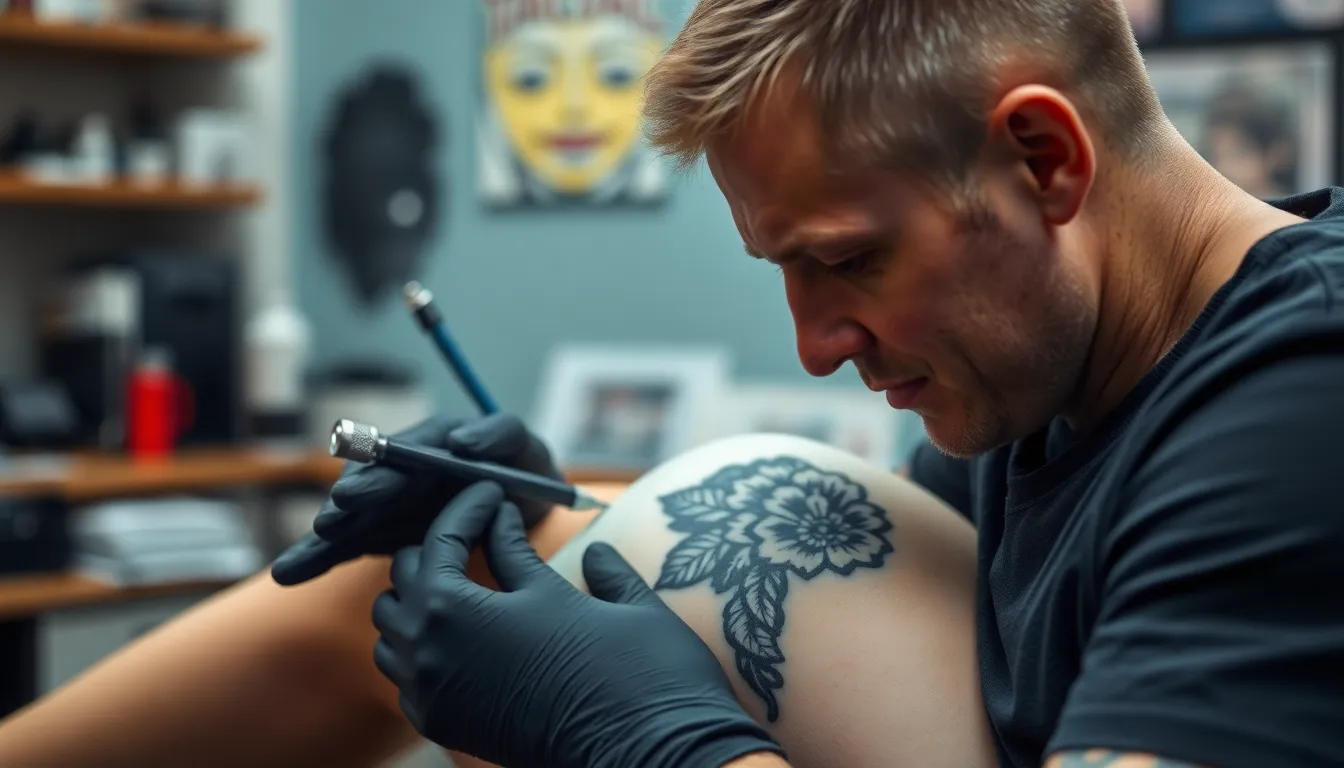
Collaborating with skilled tattoo professionals transforms your leg stencil vision into exceptional artwork. Success depends on choosing the right artist and establishing clear communication throughout the entire process.
Finding the Right Artist for Men’s Leg Tattoos
Researching specialized artists who focus on men’s leg tattoos ensures you’ll work with someone who understands masculine aesthetics and leg anatomy. Portfolio reviews reveal artists’ expertise in leg sleeves, thigh pieces, calf designs, and shin tattoos that showcase bold stencil work. Local studios known for blackwork and stencil styles often house artists who excel at creating striking, graphic appearances on leg surfaces.
Experience with leg contours separates exceptional artists from average ones. Artists who’ve mastered working with the leg’s unique curves and skin texture produce more precise, visually appealing results. Their portfolios typically feature geometric patterns, wildlife motifs, and abstract designs that flow naturally with masculine leg anatomy.
Studio reputation matters when selecting your tattoo professional. Established shops maintain higher hygiene standards and employ artists with proven track records in men’s leg stencil work. Reviews from previous clients highlight artists’ communication skills, technical precision, and ability to execute complex stencil designs.
Communication and Design Consultation
Clear vision sharing starts your collaborative journey on the right path. Bring reference images from sources like Pinterest to help your artist understand your exact stencil preferences for geometric patterns, animals, or abstract designs. Visual examples eliminate confusion and ensure both parties share the same creative direction.
Size and placement discussions determine your tattoo’s overall impact and functionality. Artists assess your leg’s proportions to recommend optimal sizing that enhances rather than overwhelms your natural anatomy. They’ll consider how your daily activities might affect the tattoo’s appearance and longevity.
Cultural sensitivity conversations prevent potential issues with tattoo content. Professional artists discuss any cultural symbols or themes to avoid designs that might be taboo or offensive. This consultation ensures your stencil design remains respectful while conveying the strength and individuality you desire.
Budget and timeline planning establishes realistic expectations for your leg tattoo project. Artists explain how stencil complexity affects session duration and total cost, helping you prepare financially and schedule appropriately.
Stencil Transfer Process
Traditional transfer methods form the foundation of professional stencil application. Artists draw or print your design on specialized transfer paper, then apply it to your leg using transfer answers that create clear, precise outlines. This critical step ensures accuracy and proper placement on your leg’s curved surfaces.
Precision placement techniques minimize errors before permanent inking begins. The stencil transfer allows you to visualize exactly how your tattoo will appear on your leg, including how it interacts with muscle definition and natural contours. Artists make adjustments to optimize the design’s flow with your anatomy.
Error prevention protocols save time and ensure satisfaction with your final tattoo. The stencil serves as a roadmap during tattooing, maintaining consistency throughout multiple sessions if your design requires them. This process particularly benefits large leg pieces where precision across extended areas becomes crucial.
Quality control measures include stencil review and approval before needle touches skin. Artists ensure the transfer appears crisp and complete, with all design elements properly positioned. Any smudging or incomplete areas get corrected before tattooing begins, maintaining the integrity of your chosen stencil design.
Maintaining Your Leg Tattoo Stencil During Long Sessions
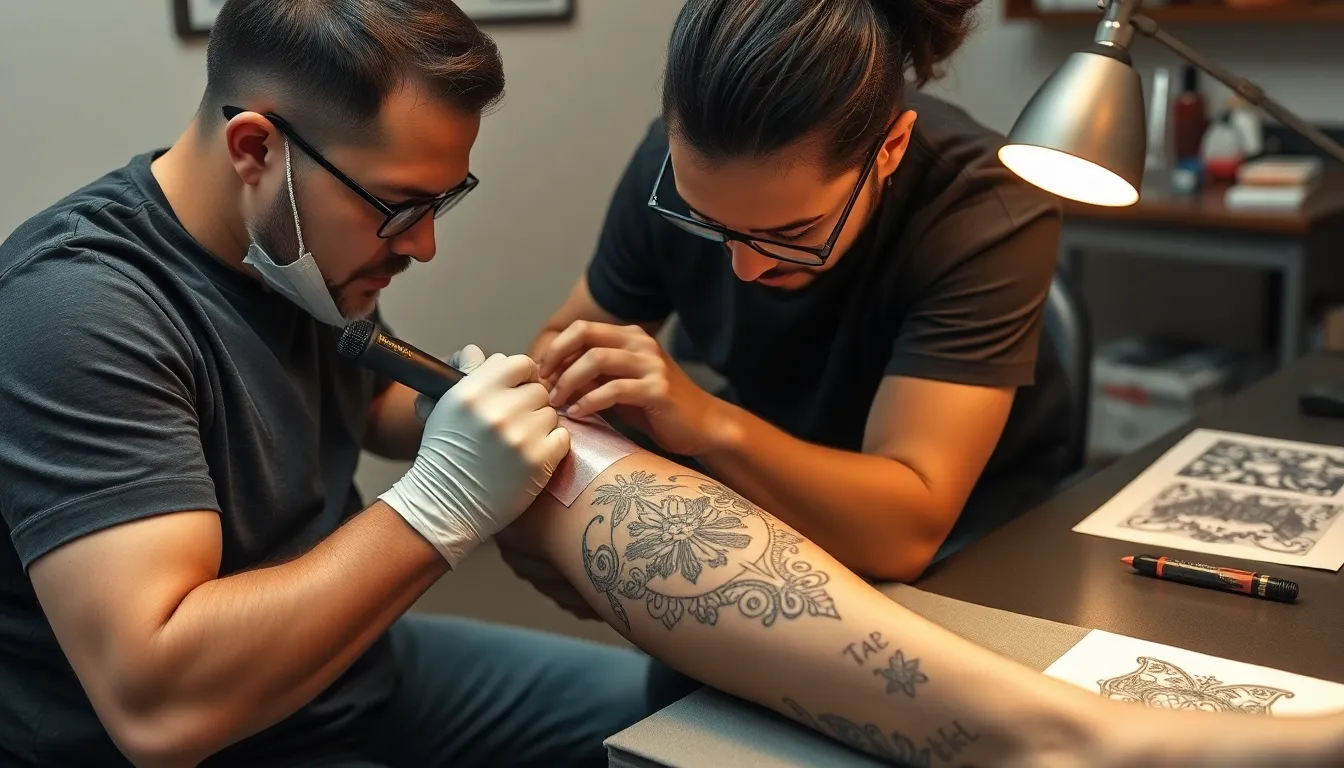
Extended tattooing sessions on legs present unique challenges for stencil preservation. We’ll share proven techniques to keep your stencil crisp and accurate throughout lengthy appointments.
Stencil Longevity Tips
Proper skin preparation forms the foundation of stencil longevity during extended leg tattoo sessions. Shave the entire tattoo area completely and cleanse it thoroughly with antibacterial soap to remove oils and dirt that can compromise stencil adhesion.
Apply stencil solution or stick deodorant evenly across the cleaned skin surface to create an ideal base for secure stencil attachment. This simple step prevents premature smearing and extends the stencil’s working life significantly.
Place the stencil carefully with appropriate pressure and allow it to dry for 15 to 20 minutes before beginning the tattoo work. This drying period ensures the design sets properly on the skin and won’t lift during the initial tattooing phases.
Create small slits around stencil paper edges when working on curved areas of the leg to help the design mold to your skin’s natural contours. This technique maintains stencil integrity even when your leg moves during positioning changes.
Choose high quality stencil papers and answers to reduce smearing risks and ensure clearer transfers even though leg movement and sweating throughout extended sessions.
Touch-Up Procedures
Re trace faded stencil lines with a fine Sharpie marker when parts of the design begin to fade or wipe off during lengthy tattoo sessions. This precision touch up method maintains design accuracy while preserving the original stencil outline.
Clean smudged areas gently if stencil smearing occurs during the session, then reapply the stencil or make necessary touch ups to affected sections. Avoid excessive rubbing that can further damage the remaining stencil areas.
Monitor stencil condition regularly throughout the session and address any deterioration immediately to prevent design distortion. Early intervention saves time and ensures consistent tattoo quality from start to finish.
Managing Sweat and Movement
Apply a thin layer of Vaseline or Green Glide over the stencil to protect it against sweat and friction during long leg tattoo sessions. This protective barrier preserves the design while allowing smooth tattoo machine operation.
Take strategic breaks to let your skin rest and dry when sweat buildup becomes problematic during extended sessions. These brief pauses help manage moisture accumulation that can compromise stencil integrity.
Position yourself to minimize leg movement during tattooing by using proper supports and maintaining comfortable positioning throughout the session. Reduced movement helps preserve stencil clarity and prevents unnecessary smearing.
Control room temperature and ventilation to minimize excessive sweating that can affect stencil longevity during lengthy appointments. A cooler environment reduces perspiration and extends stencil working time significantly.
Budget Considerations for Men’s Leg Tattoo Stencils and Artwork
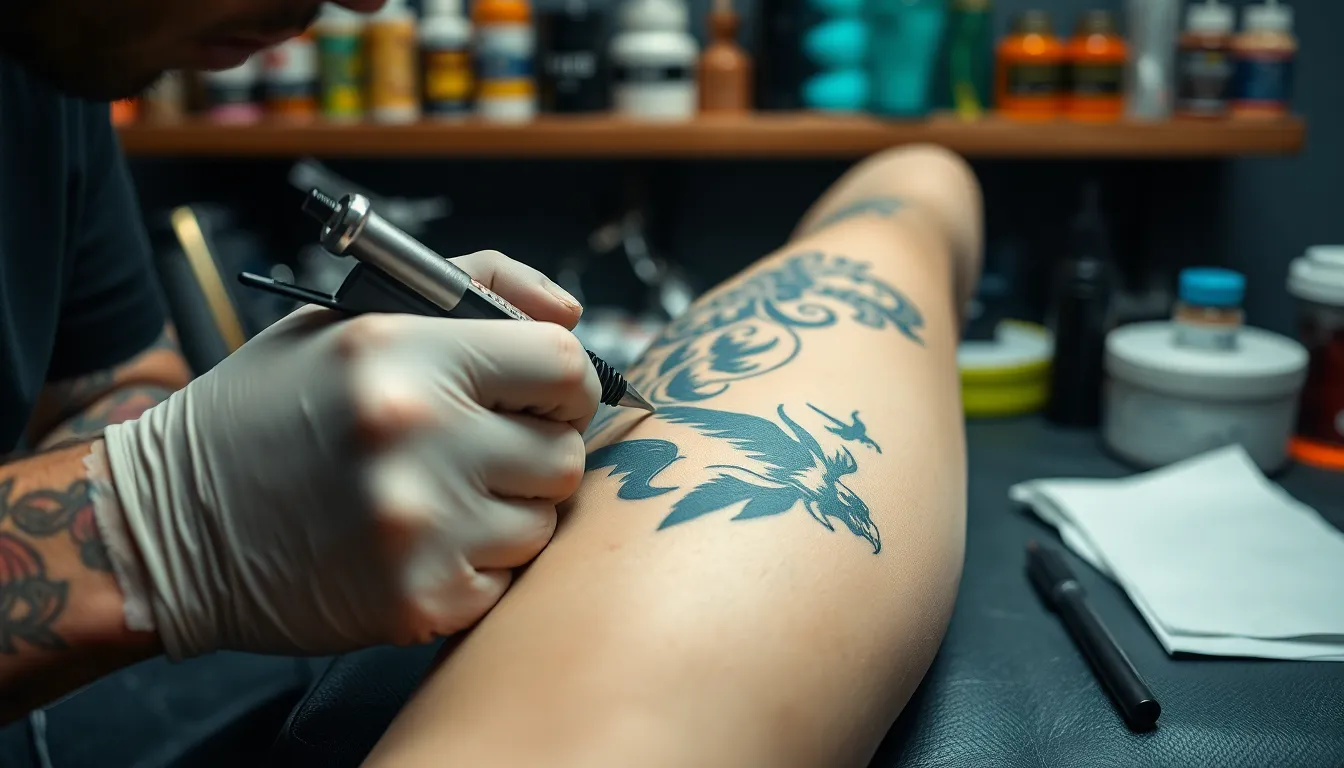
Understanding the financial investment required for men’s leg tattoo stencils and artwork helps us make informed decisions about our ink journey.
Stencil Creation Costs
Stencil creation costs are typically included in the overall tattoo pricing rather than itemized separately. Most professional tattoo artists incorporate stencil fees into their standard service rates, making it easier for us to budget without unexpected add-ons. Complex designs requiring multiple stencil adjustments might incur additional charges, though these costs remain minimal compared to the overall tattoo investment.
Custom stencil work becomes more expensive when we request intricate modifications or detailed artwork that demands extra preparation time. Artists rarely charge separately for basic stencil creation since it’s considered part of their standard tattooing process. We can expect stencil costs to be absorbed into the artist’s hourly rate or project fee structure.
Artist Fees and Time Investment
Artist fees represent the largest portion of our leg tattoo budget, with pricing structures varying based on experience and reputation. Hourly rates create the foundation for most tattoo pricing, making time investment a crucial budget factor for men’s leg tattoos.
Experience levels directly impact our costs across different artist categories:
| Artist Experience Level | Hourly Rate Range |
|---|---|
| Beginner Artists | $80-$120 |
| Established Artists (5-10 years) | $120-$180 |
| Highly Experienced/Famous Artists | $150-$500 |
Project size significantly affects our total investment for men’s leg tattoo artwork. Small to medium leg tattoos typically cost between $150 and $1,000, depending on detail complexity and artist selection. Large or full leg tattoos can reach $1,500 to over $5,000 due to extensive time requirements and artistic skill demands.
Multiple sessions become necessary for larger leg pieces, multiplying our hourly investment across several appointments. Each session includes stencil application, shading work, and detailed finishing touches that contribute to the cumulative cost. We should plan for 2-6 sessions depending on our chosen design’s size and complexity.
Additional Supplies and Aftercare
Additional supplies beyond artist fees include standard tattoo materials that studios typically cover in their pricing. Needles, inks, disposable gloves, and stencil paper represent operational costs that artists include in their service rates. We don’t usually pay separately for these basic tattooing supplies during our leg tattoo sessions.
Aftercare products require our direct investment to ensure proper healing and tattoo longevity. Quality healing ointments and specialized lotions cost between $10 and $30, depending on brand selection and product size. We should budget for these essential aftercare items as part of our overall tattoo investment.
Professional aftercare guidance comes included with our tattoo service, though premium healing products might cost extra if we choose specialty brands. Planning for aftercare expenses ensures we maintain our leg tattoo’s appearance and prevent complications during the healing process.
Common Mistakes to Avoid When Using Leg Tattoo Stencils
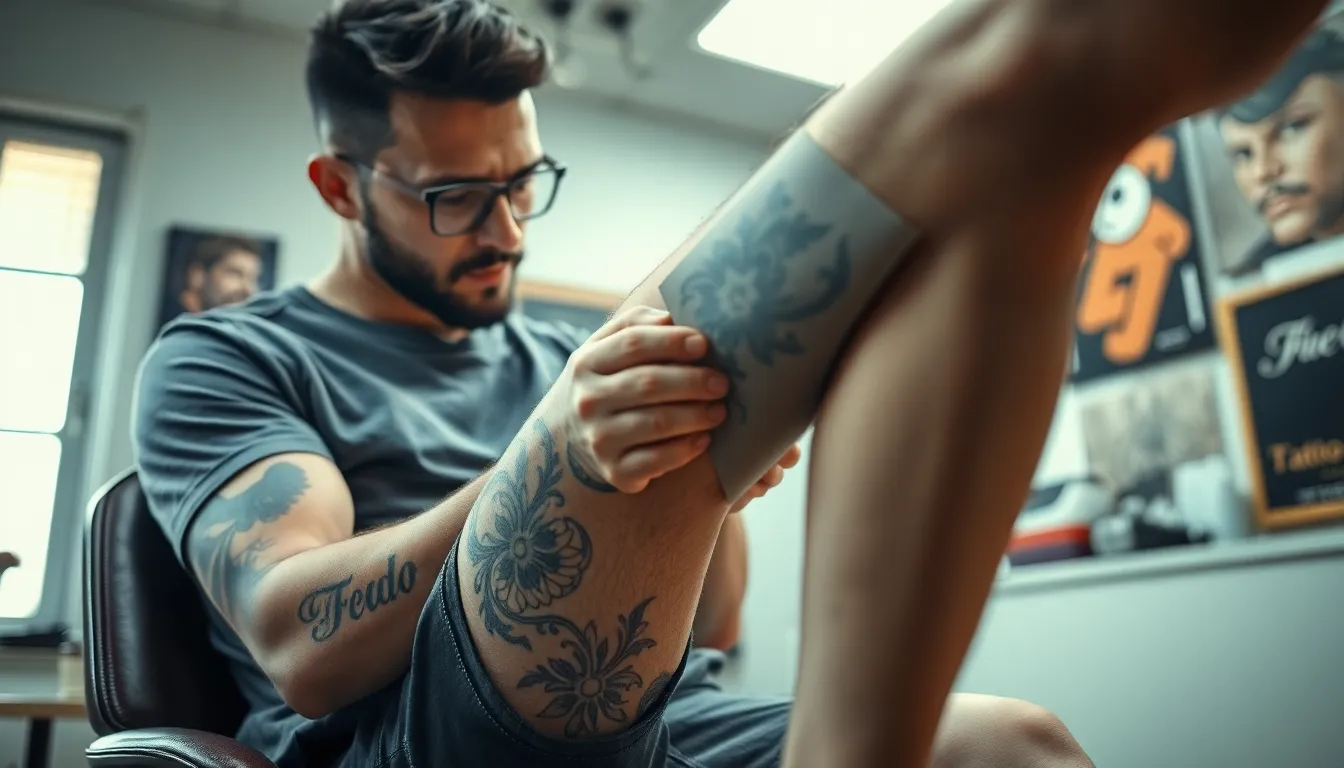
Even experienced tattoo enthusiasts can make critical errors that compromise their leg tattoo’s final appearance. We’ve identified the most common pitfalls that affect stencil quality and overall tattoo success.
Sizing and Proportion Errors
Underestimating the leg canvas leads to awkward or incomplete tattoo designs that look disproportionate on the body. Many men fail to consider the entire leg area when planning their tattoo, especially for leg sleeves that require careful proportional planning to cover the space effectively.
Cramped designs result when we don’t account for the leg’s natural shape and available surface area. The leg provides substantial canvas space, and designs that are too small can appear lost or insignificant on this larger body area.
Misaligned proportions occur when stencil sizing doesn’t complement the leg’s muscle definition and natural contours. We must ensure the design flows with the leg’s anatomy rather than fighting against its natural shape.
Placement Misjudgments
Ignoring leg curvature creates distortion issues that affect how the final tattoo appears from different angles. The leg’s natural curves and muscle definition can significantly alter a design’s appearance if we don’t position the stencil properly during application.
Avoiding challenging areas like knees becomes crucial since these locations may not hold tattoos well over time. We recommend choosing prime areas of the leg that offer stable skin surfaces for detailed work.
Overlooking sun damage and other skin conditions can compromise the tattoo’s quality and longevity. Damaged skin affects how well detailed work appears, making careful placement selection even more important for achieving clean, lasting results.
Stencil Transfer Issues
Uneven stencil application causes inaccurate outlining that leads to mistakes during the actual inking process. Poor application technique, skin texture variations, or excessive movement during transfer can result in incomplete or distorted stencil impressions.
Improper skin preparation before stencil application affects how well the transfer adheres to the leg surface. We must ensure the skin is properly cleaned and prepared to receive the stencil for optimal transfer quality.
Technical pressure mistakes during stencil application can compromise the transfer’s clarity and accuracy. Incorrect pressure application or mismatched machine settings can affect the stencil’s role in guiding the tattoo process, making proper technique essential for flawless results.
Conclusion
Getting the perfect leg tattoo stencil sets the foundation for artwork you’ll wear with pride for years to come. We’ve covered everything from design selection and sizing to professional collaboration and common pitfalls to avoid.
Remember that investing in quality stencil work and choosing the right artist makes all the difference in your final results. Take time to prepare properly and communicate clearly with your tattoo professional throughout the process.
Your leg offers an incredible canvas for creative expression. With the right stencil approach and attention to detail we’ve outlined here you’re well-equipped to make informed decisions that’ll result in stunning tattoo artwork that perfectly complements your style and anatomy.
Frequently Asked Questions
What are leg tattoo stencils and why are they important?
Leg tattoo stencils are blueprints that serve as templates for transforming designs into permanent artwork on your leg. They’re crucial because they ensure accurate placement, proper sizing, and help visualize how the design will flow with your leg’s natural anatomy and muscle structure before the actual tattooing begins.
How do I choose the right size stencil for my leg tattoo?
Consider your leg’s proportions and the design’s complexity. Small stencils (2-4 inches) work well for simple designs and offer placement flexibility. Medium to large stencils (4-8+ inches) are better for detailed artwork and full-leg pieces. Always account for how the design will look proportional to your specific leg anatomy.
What are the most popular leg tattoo stencil designs for men?
Popular designs include tribal patterns that emphasize masculine strength, nature motifs like wolves or mountains, sports-related imagery, geometric patterns, and biomechanical designs. These themes complement the leg’s natural shape and reflect masculine aesthetics while offering versatility in placement and sizing options.
How much do leg tattoo stencils typically cost?
Stencil creation costs are usually included in your overall tattoo pricing. Total investment for leg tattoos ranges from $150 for small designs to over $5,000 for complex full-leg pieces. Artist fees vary based on experience level, design complexity, and session length. Budget additionally for aftercare products.
How do I prepare my leg for stencil application?
Clean your leg thoroughly with antibacterial soap and ensure the skin is completely dry. Consider hair removal 24-48 hours before your appointment to avoid irritation. Avoid moisturizers, oils, or lotions on the day of application as they can interfere with stencil adhesion and transfer quality.
What should I look for when choosing a tattoo artist for leg stencils?
Select an artist who specializes in men’s leg tattoos and has experience with stencil application. Review their portfolio for similar work, ensure they understand leg anatomy and movement, and prioritize clear communication about your vision. Professional artists will offer design consultations and quality control during stencil transfer.
How do artists maintain stencil integrity during long tattoo sessions?
Professional artists use proper skin preparation techniques, apply protective layers over unused stencil areas, and manage sweat and movement carefully. They monitor stencil condition throughout the session and perform touch-ups as needed to ensure consistent quality and accurate design placement from start to finish.
What are common mistakes to avoid with leg tattoo stencils?
Avoid sizing errors that don’t complement your leg proportions, improper placement that ignores muscle structure, and inadequate skin preparation. Don’t underestimate the leg canvas complexity or ignore natural curvature. Ensure proper stencil transfer to prevent blurred lines or incomplete design elements that compromise the final result.
